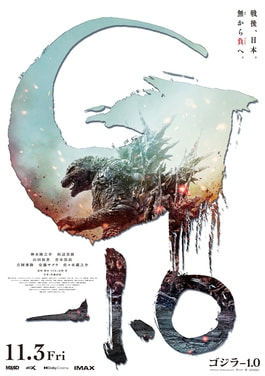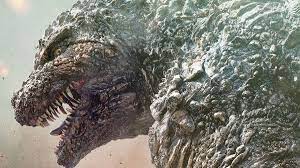|
“Godzilla Minus One” stars Ryunosuke Kamiki, Minami Hamabe, Yuki Yamada, Munetaka Aoki, Hidetaka Yoshioka, Sakura Ando, and Kuranosuke Sasaki. Released in Japan on November 3, 2023, followed by a U.S. release on December 1, 2023, the film has the citizens of postwar Japan encountering the emergence of Godzilla. The film was written and directed by Takashi Yamazaki, who also directed films such as “Juvenile,” “Always: Sunset on Third Street,” “The Eternal Zero,” and “The Great War of Archimedes.” It is the 37th film in the Godzilla franchise. With the holidays approaching, it would’ve been fitting for me to sit by the fire, drink some hot chocolate, and watch many Christmas-themed movies and specials. But that’s not the case, at least for this year. Instead, I’m celebrating the Christmas season with the iconic atomic-breathing lizard known for destroying countless buildings and delightfully terrorizing civilians and movie audiences. While Godzilla has had its recent success in America thanks to the 2014 reboot and the MonsterVerse, that didn’t mean Japan wouldn’t continue making its own films featuring the famous kaiju. Enter the franchise’s “Reiwa” era, which has the series reverting to Godzilla just destroying stuff, starting with 2016’s “Shin Godzilla”. Since we’re not getting another Americanized Godzilla film until next year, and this latest Reiwa installment is showing at my closest cinema, I decided to take the opportunity to experience a Japanese-dub Godzilla movie on the big screen for the first time. What a way to celebrate the franchise’s 70th anniversary. Does it live up to the expectations as massive as the titular character, or does it deserve a score lower than a minus one? Let’s find out. The story takes place in post-World War II Japan. It follows Kōichi Shikishima (Kamiki), a former kamikaze pilot plagued by survivor’s guilt following his close encounter with a massive creature called Godzilla. Kōichi has started a relationship with Noriko Ōishi (Hamabe), and they’ve adopted a child named Akiko (Sae Nagatani), whose parents were killed during the war. Kōichi’s new life was suddenly altered by the reappearance of Godzilla, who’s mutated by the United States’ nuclear tests. As the monster seeks to destroy Japan, Kōichi and the other private citizens join forces to protect their country from a fate worse than the war they fought. When it comes to the Godzilla franchise, I only know it through the Hollywood iterations of the titular creature, especially the MonsterVerse installments. Yes, that also includes the infamous 1998 film from Roland Emmerich. Sorry, not sorry. However, I recently came around and watched one of the Godzilla films from Toho, “Godzilla: Final Wars”. I even watched the previous films in the Reiwa era, including the 2016 reboot “Shin Godzilla,” which I thought was good despite being a bit long and periodically goofy. So, while my experience with Toho’s Godzilla is more diminutive than America’s take on the creature, my knowledge overall is enough to experience another round of kaiju chaos early. That’s right, I managed to be one of the lucky folks to see “Godzilla Minus One” early before it hits American theaters this weekend, and guess what? I’m pleased that I took that chance. Many of the Godzilla movies have been known for relying on the spectacle of Godzilla destroying cities, people, and other kaiju over a human-focused narrative. They’re not without their crowd-pleasing moments that’ll satisfy plenty of fans. However, those can only take them so far if they don’t have characters worth caring about amid the destruction, at least for general moviegoers. “Godzilla Minus One” did the impossible by being the exception to that 70-year-old tradition. On paper, it had the makings of a classic Godzilla movie with the titular kaiju laying waste to Tokyo. However, it’s also accompanied by the human soul that surprisingly works well with the monster-sized action, more so than the MonsterVerse Godzilla movies. It satisfies as an engaging back-to-basics monster movie and a well-acted and grounded war drama whose real-life themes and likable characters drive the narrative to sentimental heights. Of course, this also means this is another movie where the main focus is on the human characters, with Godzilla appearing in fewer scenes than the war veterans. For people who want to see Godzilla wreck stuff for two hours straight, it can be concerning to wait through the “boring” conversations to get back to the action. Fortunately, “Minus One” was able to make the human characters just as entertaining, tense, and emotional as the Godzilla sequences. One of those reasons is its themes. Amid the kaiju chaos, the film explores Kōichi’s inner conflict caused by PTSD and survivor’s guilt and the post-war effects on humanity, particularly in Japan. We see Kōichi struggling to face his phobia of Godzilla while attempting to find his inner courage to live his life. It reflects the human spirit shining through the tragedy and sorrow caused by war, anxiety, and violence, especially when they’re caused by a giant dinosaur-like creature. It can be a bit melodramatic at times, and the ending left me feeling a bit conflicted compared to the rest of the movie. However, “Minus One” effectively balanced the melodrama with realism to prevent it from being an uneven cheese-fest. Takashi Yamazaki is no stranger to historical war dramas, as he’s done “The Eternal Zero” and “The Great War of Archimedes” beforehand. However, I’m surprised to discover that the filmmaker also has experience with Godzilla, as he previously used the monster for 2007’s “Always: Sunset on Third Street 2” and “Godzilla: The Ride” at Seibu-en Amusement Park. Based on that interesting information, I assumed they had the right person for the job. After watching the film, I will gladly say my assumption was correct. Yamazaki did an impressive job honoring the brutal and menacing persona of Godzilla while also ensuring that the story and characters come first, mainly from his well-written screenplay. Yamazaki’s vision for the production designs and grim tone is a remarkable sight to behold, and the cinematography by Kōzō Shibasaki was sublime in capturing the incredible scope of the action, destruction, and even the human drama. These elements are why the film is worth seeing on the biggest screen possible, along with its sound mixing. The cast also did wonders in making the characters worth caring about through their performances. Ryunosuke Kamiki did a superb job resembling Kōichi as an internally broken man who blames himself for his cowardliness. Some of his emotional range can be a bit much, but Kamiki had a good amount of restraint in his portrayal that doesn’t stray into B-movie territory. Minami Hamabe was also effective as Noriko, Kōichi’s partner who helps him ease his pain and raise their adopted child. I will also credit the supporting actors playing the members of the minesweeper crew for delivering a solid mixture of humor and drama, including Hidetaka Yoshioka as Kenji Noda and Kuranosuke Sasaki as Yōji Akitsu, the crew’s captain. Finally, we have the film’s visual effects, which blew my mind from beginning to end. There’s no other way to describe how incredibly awe-inspiring the visuals looked. They’re just that amazing to witness, especially the design for Godzilla, which I admit looks badass and terrifying. What makes them even more impressive is that the film costs $15 million, excluding the marketing. The fact that a monster movie from Japan with a smaller budget looks better than the recent Hollywood blockbusters that cost millions of dollars to make is both amusing and embarrassing to me, mostly the former. It seems that Hollywood is still struggling to improve its quality since the pandemic. Overall, “Godzilla Minus One” is a satisfyingly massive feat in the 70-year-old kaiju franchise that combines classic monster action with a compelling and thoughtful human soul. Despite a couple of tiny issues with the story, including the ending, the film is a refreshing and highly engaging experience that honors the Godzilla lore and balances the blockbuster spectacle with heart. Something that many other blockbusters from Hollywood have struggled to capture recently. Thanks to its attention-grabbing cast, Yamazaki’s brilliant approach via his direction and script, and the incredible visuals, “Minus One” is the best Godzilla movie I’ve seen. With Warner Brothers and Disney concluding their anniversaries with little to no fanfare, it’s nice to see the iconic kaiju avoiding a similar fate by delivering the near-perfect movie to celebrate its milestone. Here’s to 70 more years of Godzilla wrecking its way to our kaiju-sized hearts! A-
0 Comments
Leave a Reply. |
Home of the most friendly movie reviews on the planet.
Categories
All
Follow Me |
- Home
- Classic Reviews
- 2015 Reviews
- 2016 Reviews
- 2017 Reviews
- 2018 Reviews
- 2019 Reviews
- 2020 Reviews
- 2021 Reviews
- 2022 Reviews
- 2023 Reviews
- 2024 Reviews
- Movie Talk
-
Fan Fictions
-
Ed, Edd n Eddy: The Ultimate Ed-Chronicles
>
-
The 'Beginnings' Saga
>
- Ed, Edd n Eddy: The Rise of Maleficent >
- Transformers: Legend of the Black Cauldron >
- Ed, Edd n Eddy meets the Penguins of Madagascar >
- The Eds and Iron Man: Dawn of the Blowhole >
- Ed, Edd n Eddy: The Fast and the Furious >
- The Eds and Kung Fu Panda: Battle for China >
- Ed, Edd n Eddy and the Lion King: The Full Circle >
- Ed, Edd n Eddy meets Thumbelina: Revenge of the Shredder >
- Ed, Edd n Eddy: Journey to Neverland >
- Ed, Edd n Eddy: All Tangled Up >
- Ed, Edd n Eddy's Frozen Adventure >
- Ed, Edd n Eddy's Edventures in San Fransokyo
- Ed, Edd n Eddy: Return to Neverland
- Ed, Edd n Eddy vs The League of Evil
-
The 'Avengers' Saga
>
- The Eds and the Little Mermaid: Age of Extinction
- Ed, Edd n Eddy meets the Ghostbusters
- Ed, Edd n Eddy: A Sea of Adventure
- Ed, Edd n Eddy meets Anastasia
- Ed, Edd n Eddy in Who Framed Roger Rabbit?
- Ed, Edd n Eddy meets the Incredibles
- Ed, Edd n Eddy and the Lion King 2: Simba's Pride
- Ed, Edd n Eddy: Brand New Zootopia
- Ed, Edd n Eddy: Into the Sugar Rush
- Ed, Edd n Eddy and the Big Sea Quest
- Ed, Edd n Eddy: Heroes Assemble
- Fastformers: Rio Heist
- The Loud Ghostbusters >
-
The 'Beginnings' Saga
>
-
Ed, Edd n Eddy: The Ultimate Ed-Chronicles
>
- Contact
- About


